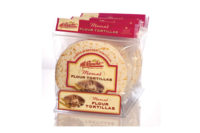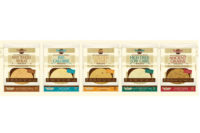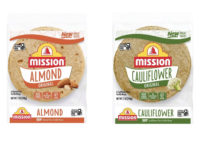State of the Industry: Tortillas’ terrific timing










Our 2013 State of the Industry report explores market information for the bread aisle, sweet goods, cookies, bars, snack cakes, frozen baked goods, tortillas, pies and more.
Just as auto racing has followers around the world, tortillas are getting the green light from consumers of all ethnicities for their versatility, convenience, healthy ingredients and gluten-free options.
Whether they live in an urban area with a well-known speedway or in small town with a two-lane dragstrip, most Americans are familiar with Mexican food and tortillas today. The proliferation of national chain restaurants like Chipotle Mexican Grill and Taco Bell, along with countless mom-and-pop eateries, ensures that tortillas can satiate cravings for tacos, burritos and other Mexican fare seemingly anywhere, anytime.
Most grocers offer an assortment of Mexican products, including those from national and regional tortilla brands, for people who prefer to make their Mexican dishes. But not all of these tortillas become Mexican staples. Thanks to recipe websites, social media and cooking magazines and TV shows, consumers are also using tortillas to make sandwiches, pizza, soups, salads, desserts and more.
“The statistics kept by the [American Institute of Baking International] make it easy to report that the growth of the tortilla industry as a whole remains excellent,” says Charlene Richardson, director of marketing, Circle Foods, LLC, San Diego, maker of TortillaLand Tortillas. “In fact, its statistics reveal that in 1997, tortilla sales totaled more than $2 billion. In 2011—15 years later—sales increased by 500% to over $10 billion.”
Richardson attributes this incredible growth to several factors: The popularity of Mexican food as it continues to grow and become a mainstream item; the versatility and convenience of tortillas and their increased usage among national quick-serve restaurants (QSRs); and the emerging Millennial shopper, who looks for simple, nutritional ingredients and labels.
Made with just five natural ingredients—unbleached wheat flour, water, canola oil, salt and a pinch of sugar—TortillaLand’s Uncooked Flour Tortillas are “an integral part of the consumer’s desire for tortillas,” says Richardson. “With their unique profile, TortillaLand’s tortillas are exclusively found in the refrigerated section and, for most consumers, offer desired attributes like fresh, authentic, restaurant quality and homemade.”
The company also offers TortillaLand Uncooked Whole Wheat Tortillas, which have 33 g. of whole grains, 4 g. of fiber per serving and no cholesterol, and TortillaLand Uncooked Gluten-Free Corn Tortillas, made with corn masa flour. “One of the most unique positioning attributes of our TortillaLand Tortillas is the fact that they’re uncooked, but ready to cook,” Richardson explains. “They are like the fresh-baked cookie that you make at home. TortillaLand’s Uncooked Flour and Corn Tortillas offer freshness, home-made goodness [and] authenticity and are even considered restaurant-quality.”
TortillaLand targets several consumer groups, according to Richardson: Foodies—people who have an expressed interest in food and who are always open to new foods and new food experiences; Hispanics, who understand the fresh-cooked quality and texture of cooking a fresh tortilla but may not have the time to prepare their dough from scratch; and moms with children, who are label-conscious and looking for foods for their families that are simple, fresh, healthy and great-tasting.
“The ‘how’ of reaching each of our consumer targets is as multi-level as the target markets themselves,” she says. “We utilize many interwoven and highly active disciplines to include the TortillaLand Facebook page (nearly 17,000 fans), website, blog, Twitter (over 1,700 subscribers), YouTube and regularly distributed e-letter (over 30,000 subscribers).” The company also places ads in a variety of consumer magazines.
It’s not surprising, then, that TortillaLand Tortillas has seen its sales increase nearly 55% during the past 52 weeks versus a year ago, according to data released by IRI on Feb. 24. “I’m pleased to say we have not only doubled our distribution points in the grocery channel, we have expanded by adding TortillaLand Uncooked Gluten-Free Corn Tortillas at Walmart,” says Richardson.
Tortilla sales drivers
Another trend boosting tortilla sales in the U.S. is consumer interest in better-for-you foods. “Consumers are becoming very nutrition- and health-conscious, and looking for healthy ingredients, while keeping flavor intact,” says Jesus Martinez, director of operations of Hammond, Ind.-based Tortillas Nuevo Leon, which makes flour, whole wheat, white corn and yellow corn tortillas.
The company’s 8-in. Whole Wheat Tortillas, for instance, have 41 g. of whole grain per serving, making them a healthy alternative to many other baked goods. “Consumers are using tortillas in place of bread for many items,” says Martinez, adding that tortillas often put a healthier spin on American standards typically made with bread. “For example, instead of a grilled cheese sandwich, you can make a grilled cheese quesadilla, or instead of a ham sandwich, you can make a BLT wrap.”
Another emerging trend is consumer demand for variety, says Martinez. In response, Tortillas Nuevo Leon is adding a line of flavored tortilla wraps to its product offerings: Tomato Basil, Savory Spinach and Chipotle. “Our new line of savory-flavored tortillas can be used in a variety of ways to fit all cultures—a Greek Caesar chicken wrap, a veggie wrap, an Italian parmesan chicken wrap, a BLT wrap, a Korean taco—the possibilities are endless.” The line will be available for foodservice and retail.
Martinez says that while the Hispanic market consumes a lot of corn and flour tortilla products, the category has “expanded into the mainstream where every ethnicity is now purchasing tortilla products. So I believe everyone is [our] target market because every family enjoys ‘taco night’ at least once a week.”
Gluten-free makes Indy 500
Like many other baked goods manufacturers, tortilla makers are giving gluten-free formulas the thumbs up.
“There continues to be an increased demand for gluten-free products in general,” says Doug Radi, senior vice president of marketing and sales for Rudi’s Organic Bakery, Boulder, Colo. “Gluten-free products are sought after by people who need to consume them based on dietary restrictions as well as those who choose to eat gluten-free as part of a healthy lifestyle. Based on the demand for gluten-free products across the board, there has been specific demand for gluten-free tortillas that taste and feel just like the real thing, which is why [the company] decided to launch a line and help satisfy consumer demand.”
Rudi’s Gluten-Free Bakery launched three Gluten-Free Tortillas in late 2012: Plain; Spinach; and Fiesta, which are made with red bell pepper, jalapeno, onion and garlic flavors. Like all of the company’s gluten-free products, the tortillas are free of artificial ingredients, preservatives and genetically modified organisms (GMOs). Made with whole-grain flours, they have 5 g. of fiber per serving and a soft, pliable texture, so consumers can easily roll them into a burrito or sandwich wrap.
The company also continues to offer its line of Rudi’s Organic Tortillas in Spelt and Whole Spelt. The latter is made with 100% whole spelt flour and has 29 g. of whole grains per serving. Both are kosher and contain no GMOs, soy, dairy or high fructose corn syrup.
“We target health- and wellness-oriented consumers who are choosing either organic or gluten-free products that fit their lifestyles,” explains Radi. “These consumers are typically higher income and education, but we find them to span all demographic segments, as many consumers are interested in health.”
As part of its efforts to make consumers aware of its Gluten-Free brand, Radi says Rudi’s has talked extensively with the gluten-free community and knows that its key target market includes people with celiac disease or other gluten-intolerance issues. “Thus far in 2013, Rudi’s Gluten-Free ran a Soft and Fluffy [sandwich bread] campaign at the beginning of the year,” he says. “And we hosted a Happy Camper essay contest on Facebook during Celiac Awareness Month from May 1-31.”
Fans were able to enter for the chance to win one of 10 scholarships for their children to attend a gluten-free summer camp anywhere in the country.
“The growth in the tortilla category, like most of the bread and baked goods category, has been driven by gluten-free options,” agrees Denise Sirovatak, vice president of marketing for Denver-based Udi’s Gluten Free Foods, which recently introduced two new “flour-type,” gluten-free tortillas. Udi’s Gluten Free Plain Tortillas have the same soft texture and easy roll-ability as their gluten-containing counterparts. They come in a 9-in. burrito size and a 6-in. taco size.
“Our focus has always been creating the best gluten-free products on the planet,” Sirovatak says. “Our primary target are those eating gluten-free, whether it’s for a medical condition such as celiac disease or gluten intolerance, or because they simply think it’s a healthier alternative to wheat-based products. In either case, it’s important that the products we introduce meet our community’s taste expectations. Eating gluten-free should be a simple transition without sacrifice.”
Sirovatak adds that the company targets consumers in a variety of ways, from in-store promotions to grassroots events. “It’s about intersecting with your consumers in their daily lives,” she notes.
Making a pitstop
Despite tortillas’ popularity, tortilla manufacturers still face a few challenges as they compete for the ultimate prize—customer approval.
Tortillas Nuevo Leon, for instance, strives to stay on top of the cost and availability of certain commodities and to make sure it has technologically up-to-date equipment, so it can be “efficient and, most importantly, effective in competing in the market,” says Martinez. “You will always have a loyal customer base if you consistently deliver a quality product.”
A challenge for the industry, in general, is helping consumers understand the “enormous versatility” of the tortilla, says Richardson. TortillaLand Tortillas is finding that bloggers using its products are a good source of information and inspiration. “[Some of them] have even opened our eyes to some of the creative possibilities,” she says, offering up dishes such as grilled Hawaiian teriyaki steak wraps, and sweet tortillas paired with strawberry watermelon salsa. “The recipes are endless.”
Sirovatak also cites finding new ways in which to use tortillas as a challenge for tortilla makers. “This started with using tortillas as an alternative to bread for sandwiches,” she explains. “We just need to continue to think about other opportunities like this that will grow the entire category.”
Gearing up for success
Unlike some other baked goods categories, tortillas seem on their way to the first grid position. “With the growing Hispanic population and [consumer] awareness of their health benefits, tortillas have broken out of the niche of just being a Latino household [product],” says Martinez. “They have rapidly become a staple household item, used as bread or flatbread by many ethnicities.”
Continued consumer demand for gluten-free products also bodes well for tortilla manufacturers offering such formulations. “Right now, gluten-free is on fire and driving growth in bread, bagels and baked goods,” says Sirovatak. “The introduction of flour-like tortillas should positively impact the tortilla category in the next couple of years.”
“Personally, I don’t believe tortillas have reached their peak in popularity,” adds Richardson. “I believe many, many more new consumers will try, taste and begin to
Looking for a reprint of this article?
From high-res PDFs to custom plaques, order your copy today!











